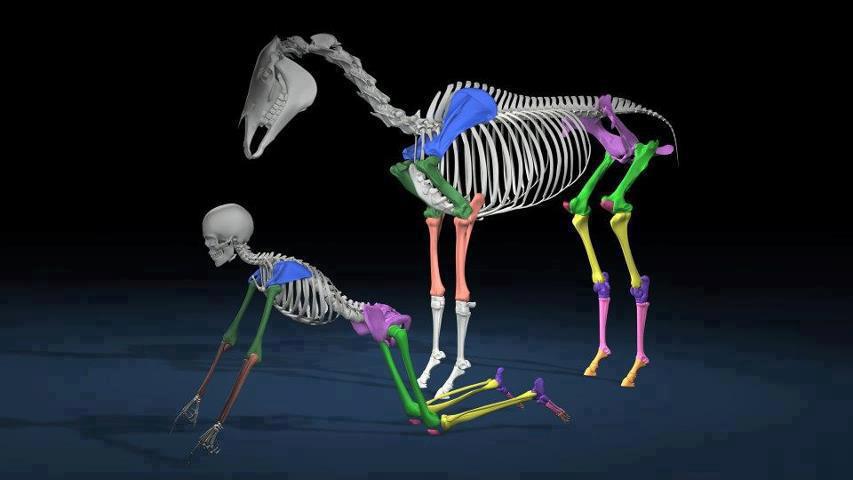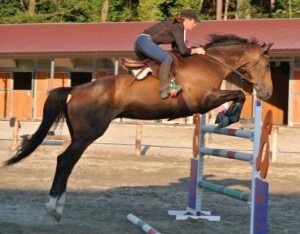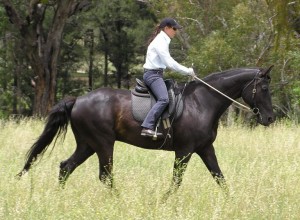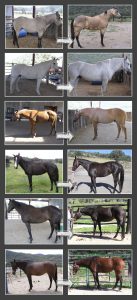 What riding horses with correct biomechanics means is that horses will stay sound, be healthy, be athletic, reach their highest potential and enjoy being ridden. When ridden in a biomechanically correct or efficient way, seemingly strenuous activities are relatively effortless. When ridden in a biomechanically inefficient or incorrect way simple tasks are a big effort, they quickly become tiring, uncomfortable even to the point of painful and lead to mental, emotional stress and behavioral problems. Good biomechanics equals good posture and good posture leads to the healthy functioning (correct positioning and optimal functionality) of all of the internal organs in the horse. Good biomechanics thereby directly affects the health and well being of the horse and poor biomechanics adversely affects the horse. Once I realised this, I realised that good posture was not something that was only important if you wanted to do dressage or showing and needed a certain look, or if you wanted to maximize performance in a specific discipline, it was important for EVERY ridden horse, even your weekend trail riding horse. To me, good biomechanics is an essential part to good horsemanship and it is one of the missing pieces in most horse training programs.
What riding horses with correct biomechanics means is that horses will stay sound, be healthy, be athletic, reach their highest potential and enjoy being ridden. When ridden in a biomechanically correct or efficient way, seemingly strenuous activities are relatively effortless. When ridden in a biomechanically inefficient or incorrect way simple tasks are a big effort, they quickly become tiring, uncomfortable even to the point of painful and lead to mental, emotional stress and behavioral problems. Good biomechanics equals good posture and good posture leads to the healthy functioning (correct positioning and optimal functionality) of all of the internal organs in the horse. Good biomechanics thereby directly affects the health and well being of the horse and poor biomechanics adversely affects the horse. Once I realised this, I realised that good posture was not something that was only important if you wanted to do dressage or showing and needed a certain look, or if you wanted to maximize performance in a specific discipline, it was important for EVERY ridden horse, even your weekend trail riding horse. To me, good biomechanics is an essential part to good horsemanship and it is one of the missing pieces in most horse training programs.
What I teach demystifies, un-complicates and simplifies equine biomechanics, posture and conformation. The teaching is in layman’s terms and it will also explain and put perspective on all the terms commonly used in this regard – things like collection, engagement, self carriage, balance, on the bit and vertical flexion.
My experience in biomechanics first came through my time as a vaulter (gymnast on horses) representing Australia in the World Equestrian Games, then through Feldenkrais (body awareness through movement) and martial arts, namely Aikido. I have also learned and practiced many body work modalities. This, combined with learning about equine biomechanics from Gavin Scofield (equine osteopath) and Carol Brett and Lesley Ann Taylor from BALANCE saddles and many years of experimenting with horses, has led me to what I teach today.
 One of the first things to realise about equine biomechanics is that all breeds of horses whether they are a draft horse or a miniature or anything else in between, have the same skeletal structure, so the basic biomechanics are the same. It also doesn’t matter what discipline or sport you are doing, the same biomechanical principles apply. It makes no difference whether you have a campdrafter, western pleasure horse, dressage horse, cutting horse, reining horse, endurance horse, trail riding horse, jumping horse or anything else. There can be differences in the “frame” or “outline” due to the varying degrees of hindquarter engagement or collection required at particular times and for a particular activities and also because sometimes hindquarter engagement is used for a heightened and more elevated stride for example in dressage, while at other times it is used for a longer stride like galloping. In general if horses have healthy biomechanics, breeds and horses from different sports should look more similar in their body shapes than they look different. For example, quarter horses that are down hill might be genetically bred like that, but it is not how they are meant to be, it is just postural and can change. The same goes for arabs who are typically renowned for hollow backs, high heads and high tails – that too is just postural and can change.
One of the first things to realise about equine biomechanics is that all breeds of horses whether they are a draft horse or a miniature or anything else in between, have the same skeletal structure, so the basic biomechanics are the same. It also doesn’t matter what discipline or sport you are doing, the same biomechanical principles apply. It makes no difference whether you have a campdrafter, western pleasure horse, dressage horse, cutting horse, reining horse, endurance horse, trail riding horse, jumping horse or anything else. There can be differences in the “frame” or “outline” due to the varying degrees of hindquarter engagement or collection required at particular times and for a particular activities and also because sometimes hindquarter engagement is used for a heightened and more elevated stride for example in dressage, while at other times it is used for a longer stride like galloping. In general if horses have healthy biomechanics, breeds and horses from different sports should look more similar in their body shapes than they look different. For example, quarter horses that are down hill might be genetically bred like that, but it is not how they are meant to be, it is just postural and can change. The same goes for arabs who are typically renowned for hollow backs, high heads and high tails – that too is just postural and can change.
Posture versus Conformation
This concept was explained to me by Gavin Scofield. Conformation is the size and shape of the bones and this can’t change much. Posture is how the bones are held together by the soft tissue – muscles, ligaments, cartilage, tendons etc. Soft tissue can be changed a lot. So therefore the shape of the horse, as determined by how the horse’s skeleton is held together with soft tissues is relatively easy to change.
What most people see as bad conformation is simply poor posture. For example, ewe necks (upside down necks which are more heavily muscled underneath), straight upright shoulders, narrow chests, sway backs, cow hocks, hunter bumps, flat croups and steep rumps are all just poor posture and even things like toes in or out can be just poor posture. I think it is very exciting, to know that all of these things can be changed. I have done loads of experiments with horses with all sorts of poor postures and been able to improve them immensely.
Where does this poor posture come from ?
1) Firstly, I believe posture is related to mental and emotional states. As humans our posture changes as our mental and emotional states change and likewise we can change our physical states to influence our mental and emotional states – this is an aspect of our physiology. Negative emotions like fear, anxiety, anger, depression or suppression, poor self esteem, sadness etc. all lead to physiologies and postural states that do not allow optimal biomechanical functioning. For example in a person who is fearful and anxious you might see a contracted chest, tight neck and rounded shoulders, shallow breathing, clenched jaw and in fact tight muscles all throughout the body. Similarly you can see these same patterns in horses. This causes horses to hollow their back, raise their head and neck and disengage their pelvis (anterior pelvic tilt).
Optimal biomechanics and physical performance come from relaxation – which implies the absence of negative emotions. Relaxation is one of the founding principles of the martial art Aikido – it is relaxation combined with correct physical form and activated energy (the feeling of being alive and full of energy). Very different than the being slouched on the couch type of relaxation. All top human athletes are being trained with this principle – How relaxed can you possibly be mentally, emotionally and physically to get that activity done? With horses most people are not noticing the signs that their horses are not fully relaxed. Most horses are doing things with some degree of stress and tension and people don’t usually notice unless it is moderate to extreme. But even minimal amounts of stress or tension are a big hindrance to having good biomechanics and happy, healthy horse partners.
Also what often happens in both horses and people, is that emotional patterns become chronic rather then temporary. Many humans and horses are living constantly in a state of underlying negative emotion (stress) which flares up when triggered or when they become overwhelmed (stacking of emotions). They are never fully returning to stillness and relaxation. When these emotions become chronic long term patterns our posture starts to get “stuck” in these poor postural patterns and they become our form (shape). This form keeps us in these emotional states and then the form strengthens, solidifies or becomes more “concrete”. It becomes a vicious cycle and spirals deeper as we age unless we interrupt the physical and emotional patterns. Most horses are living in a state of stress (at least when they are doing things with people). I am generalizing stress to cover any form of negative emotion – anxiety, fear, anger, resentment, frustration, depression, sadness, confusion and heart break are the most common emotions I see in horses.
2) Secondly I believe poor posture can be passed down through generations -both the physical postural patterns and the underlying emotional states – that still doesn’t make them confirmation when we understand the definitions of posture and confirmation as described above.
3)Thirdly horses, especially young horses, can mimic the movement patterns and emotional patterns of others, and in particular of their mothers. Science explains through mirror neurons.
4) Poor posture could be the result of an accident or injury or due to pain or discomfort for example having sore feet or teeth issues where the horse develops compensatory patterns.
5) It could be from badly fitting saddles – this is a HUGE one.
6) And last but definitely not least, poor posture is the result Poor riding/training techniques – A lot of riding styles and training techniques both on the ground and riding that are being practiced are not conducive to horses using their bodies well – Another BIG one.
Usually it is a combination of several or all of these and not just one thing in isolation that is the cause of poor posture. So to summarize we need to get our horses mentally and emotionally in a better place. Which usually requires us to develop more connection, care and compassion. We need to educate ourselves in “Functional Saddling” something that is taught by ” The BALANCE Organisation” of which I am a part of and improve our saddles if necessary. We need to educate ourselves in optimal biomechanics and employ techniques that inspire that. We may need to do a therapeutic program with our horse or ourselves and also look into whatever bodywork or stretching/movement regimes that might be needed to get ourselves and our horses functioning optimally. These are all huge focus areas in my teaching.
How will you know when you see or feel good biomechanical movement ?
This is a big topic on which several books could be written, going into all the technical details of the anatomy, but for the purpose of this right now, we are going to keep it very simple. What is important for horses is that they use their hindquarters for the power of propulsion and support, otherwise known as hindquarter engagement and this can only happen when they are relaxed in their backs and able to lift the spine (particularly the thoracic spine – under where the saddle sits). This lifting of the spine happens in combination with the pelvis rotating posteriorally (tucking under) which then allows all the joints of the hind legs – hips. stifles, hocks and fetlocks – to bend more and the hindlegs to be weight bearing further up under the horse’s body. There is a reorganization of the whole spine and the horse’s center of gravity shifts up and back.The hind legs then act like a spring to support and push up and forward and then the front end of the horse can be lightened, lifted and elevated. The opposite of this, a disengaged state, is where the horses front end (chest, shoulders and whither) drop down and forward and the horse pulls themselves along with the forehand and the hindlegs trail along behind.
There are degrees of hindquarter engagement and just like a weight lifter builds his strength to lift more weight, the horses can build their strength to further engage their hindquarters, which means carry more weight and having stronger pushing power. A horse trotting on a trail ride does not need the same degree of hindquarter engagement as a Grand Prix dressage horse or a high level jumping horse. The degrees of hindquarter engagement could be thought of like a scale from one to ten. With ten being the degree of engagement needed for the highest level of athletic performance eg. Grand Prix dressage, Grand Prix showjumping, cutting horses etc. The problem is that most horses do not even rate on the scale from 1-10 as most horses are in the minuses, below zero and yet they are still doing activities that require high levels of engagement. They find a way to get it done, but it is to the detriment of their bodies which is why so many performance horses break down and or have to have their hocks injected for example. Without correct biomechanics horses can never reach their highest potential.
 When there is correct engagement there will be RELAXATION !!!!! The highest level of power and athletic ability in any athlete, human or horse, is achieved through relaxation and when they are using energy more than physical force. This is how Olympic athletes are trained and how martial artists who study the purest energetic forms of martial arts are taught. True relaxation means having no excess muscle tension, (that means no more muscle tension than necessary to hold the skeleton in alignment or position) and being alive and full of energy throughout the whole body. Remember this is a different version of relaxation – its not the slouched on the couch version with no life or energy in the body.
When there is correct engagement there will be RELAXATION !!!!! The highest level of power and athletic ability in any athlete, human or horse, is achieved through relaxation and when they are using energy more than physical force. This is how Olympic athletes are trained and how martial artists who study the purest energetic forms of martial arts are taught. True relaxation means having no excess muscle tension, (that means no more muscle tension than necessary to hold the skeleton in alignment or position) and being alive and full of energy throughout the whole body. Remember this is a different version of relaxation – its not the slouched on the couch version with no life or energy in the body.
With this mix of relaxation and energy (power), there will be an overall feeling of effortlessness and ease in everything. There will be softness in all of the muscles and joints as opposed to rigidity or locking. The horse’s expression will be softer and happier. The horse will look and feel fluid and flowing rather than stilted or jerky, the front feet will land softly on the ground and sound lighter. Key qualities that I look for are SOFT AND SMOOTH, RHYTHM AND FLOW.
How the physical body is used affects the horses at mental, emotional and spiritual levels, just like in people. If we think of yoga for example, it is a physical activity for the original purpose of activating or developing the mind and the spirit. Bringing horses into alignment, balance and true engagement helps them to mentally and emotionally operate in a better place, it also allows them to express their spirit and experience themselves more fully.
Here are some before and after pics of just a few horses that I have worked with that made very big postural changes – transforming from ordinary to powerful, athletic, majestic and magnificent.
